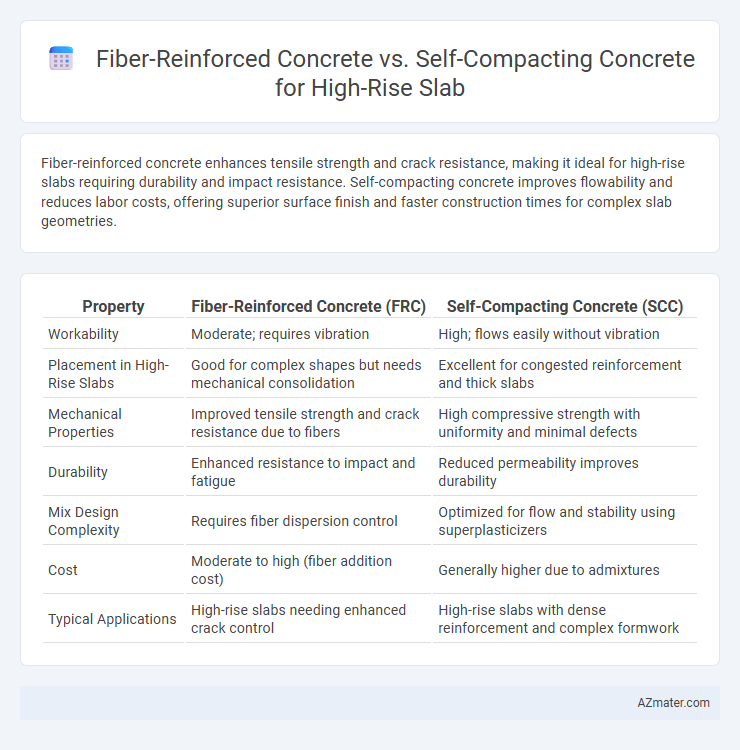Fiber-reinforced concrete enhances tensile strength and crack resistance, making it ideal for high-rise slabs requiring durability and impact resistance. Self-compacting concrete improves flowability and reduces labor costs, offering superior surface finish and faster construction times for complex slab geometries.
Table of Comparison
| Property | Fiber-Reinforced Concrete (FRC) | Self-Compacting Concrete (SCC) |
|---|---|---|
| Workability | Moderate; requires vibration | High; flows easily without vibration |
| Placement in High-Rise Slabs | Good for complex shapes but needs mechanical consolidation | Excellent for congested reinforcement and thick slabs |
| Mechanical Properties | Improved tensile strength and crack resistance due to fibers | High compressive strength with uniformity and minimal defects |
| Durability | Enhanced resistance to impact and fatigue | Reduced permeability improves durability |
| Mix Design Complexity | Requires fiber dispersion control | Optimized for flow and stability using superplasticizers |
| Cost | Moderate to high (fiber addition cost) | Generally higher due to admixtures |
| Typical Applications | High-rise slabs needing enhanced crack control | High-rise slabs with dense reinforcement and complex formwork |
Introduction to High-Rise Slab Construction
High-rise slab construction demands materials with superior strength and workability to ensure structural integrity and efficient placement. Fiber-reinforced concrete enhances tensile strength and crack resistance, making it ideal for slabs subjected to dynamic loads and long spans. Self-compacting concrete improves flowability and consolidation without mechanical vibration, enabling faster, labor-efficient construction while maintaining high durability and surface finish quality in elevated structures.
Overview of Fiber-Reinforced Concrete (FRC)
Fiber-Reinforced Concrete (FRC) integrates discrete fibers such as steel, glass, or synthetic materials into the concrete mix, enhancing tensile strength, crack resistance, and durability, making it ideal for high-rise slab applications. The improved post-cracking behavior of FRC reduces structural maintenance costs and increases life span, crucial for the demanding loads and stress distributions in tall buildings. Its adaptability in complex formworks and resistance to shrinkage and fatigue contribute to safer, more resilient high-rise concrete slabs.
Overview of Self-Compacting Concrete (SCC)
Self-compacting concrete (SCC) is a highly flowable, non-segregating concrete mix designed to spread into place and fill formwork without mechanical vibration, making it ideal for high-rise slab construction where dense reinforcement is common. SCC enhances workability, reduces labor costs, and improves surface finish quality while maintaining durability and strength. Its ability to flow under its own weight ensures complete compaction and reduces voids, leading to increased structural integrity in complex high-rise environments.
Strength and Durability Comparison
Fiber-reinforced concrete (FRC) enhances tensile strength and crack resistance in high-rise slabs by integrating synthetic or steel fibers, significantly improving toughness and post-cracking behavior. Self-compacting concrete (SCC) offers superior workability and uniform compaction without mechanical vibration, ensuring dense microstructure that contributes to durability and reduces honeycombing in complex high-rise slab forms. In terms of durability, FRC provides improved impact and fatigue resistance, whereas SCC excels in eliminating voids and segregation, resulting in enhanced long-term durability and reduced maintenance requirements.
Workability and Placement Efficiency
Fiber-reinforced concrete enhances slab durability and crack resistance but may reduce workability due to fiber entanglement, requiring careful mix design for efficient placement in high-rise slabs. Self-compacting concrete offers superior workability and placement efficiency by flowing under its own weight, eliminating the need for vibration and reducing labor time. Selecting between the two depends on prioritizing structural toughness versus ease of placement in complex formwork of high-rise construction.
Shrinkage and Crack Resistance
Fiber-reinforced concrete significantly enhances crack resistance in high-rise slabs by distributing stress through embedded fibers, reducing shrinkage-induced fissures and improving durability under structural loads. Self-compacting concrete, while excellent for flowability and avoiding segregation during placement, exhibits moderate shrinkage properties that may necessitate supplementary measures to control cracking in tall buildings. Combining fiber reinforcement with self-compacting mixes can optimize performance by minimizing shrinkage effects and maximizing crack resistance in high-rise slab applications.
Structural Performance in High-Rise Applications
Fiber-reinforced concrete enhances structural performance in high-rise slabs by increasing tensile strength, crack resistance, and ductility, reducing the likelihood of brittle failure under dynamic loads. Self-compacting concrete offers superior workability and uniformity, ensuring better compaction and density, which improves the overall durability and load distribution in complex slab geometries. Combining fiber reinforcement with self-compacting properties can optimize high-rise slab performance by merging strength enhancement with ease of placement and structural integrity.
Cost Implications and Economic Considerations
Fiber-reinforced concrete reduces labor costs and improves durability in high-rise slab construction by minimizing cracking and maintenance expenses. Self-compacting concrete, while offering faster placement and reduced vibration labor costs, generally has higher material costs due to specialized admixtures. Evaluating economic considerations involves balancing initial material expenses against long-term savings related to structural performance and construction efficiency.
Sustainability and Environmental Impact
Fiber-reinforced concrete enhances the durability and crack resistance of high-rise slabs, reducing the frequency of repairs and extending structural lifespan, which contributes to lower material consumption and waste generation. Self-compacting concrete minimizes construction noise and energy use by eliminating the need for mechanical vibration and improves material efficiency through better flowability and uniformity, leading to reduced cement paste volume and associated carbon emissions. Both concretes promote sustainable construction, but fiber-reinforced concrete excels in long-term carbon footprint reduction, while self-compacting concrete optimizes immediate environmental performance during casting.
Choosing the Right Concrete Type for High-Rise Slabs
Fiber-reinforced concrete enhances tensile strength and crack resistance, making it ideal for high-rise slabs subjected to dynamic loads and seismic activity. Self-compacting concrete offers superior flowability and uniformity, reducing labor costs and ensuring dense compaction in complex formworks typical of tall structures. Selecting between these concretes depends on structural requirements, with fiber-reinforced concrete favored for durability and impact resistance, while self-compacting concrete excels in workability and minimizing construction time.

Infographic: Fiber-reinforced concrete vs Self-compacting concrete for High-rise slab
 azmater.com
azmater.com